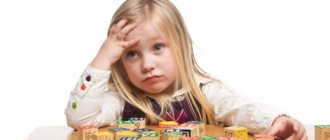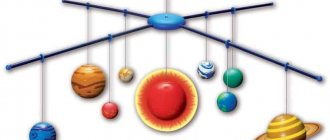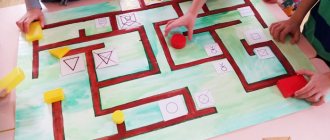What is the TRIZ system and how does it teach children to be resourceful and think independently?
The word “savvy” has been undeservedly forgotten by us, although we all use it (and it would be better even more often). And even critical thinking cannot become a full replacement for it. The ability to grasp the essence of a problem and find non-standard solutions for it is the “savvy” that the TRIZ system, or the theory of solving inventive problems, teaches.
Useful Mela newsletter twice a week: Tuesday and Friday
SUBSCRIBE
How TRIZ pedagogy appeared
The system appeared in the middle of the 20th century, and at first it was not even related to pedagogy. In 1946, Soviet engineer, scientist and science fiction writer Genrikh Altshuller began studying the techniques most often used by inventors. There were about forty such techniques, and all of them, together with the algorithm for solving inventive problems (ARIZ), formed the basis of TRIZ.
During this time, it acquired new algorithms, and by the early 80s they began to use it as the basis for teaching methods in experimental classes and schools. The goal of TRIZ pedagogy is the development of flexible thinking and imagination, the ability to solve complex problems in elegant and effective ways.
Altshuller found out that any technical problem leads to a situation in which every inventor finds himself: a moment when a solution has not yet been found, but there are many options around. The trial and error method is an unreliable and energy-intensive method, which does not guarantee excellent results. The scientist came to the conclusion that the most effective solution is achieved using existing resources, that is, in the process of solving a problem, you need to cut off everything unnecessary, then the answer will become obvious.
Genrikh Saulovich Altshuller, author of the Theory of Inventive Problem Solving (TRIZ)
TRIZ pedagogy has little in common with classical and developmental pedagogy. Firstly, there are no grades or a single correct answer: children must reason, reflect, look for contradictions and unusual signs in the conditions of the task. Secondly, in order to begin the basics of TRIZ pedagogy, a child does not necessarily have to be able to read, write and count: you can work with a child from the moment he becomes able to distinguish a game from reality, that is, from about 2. 5-3 years.
TRIZ methods
In the process of solving TRIZ problems, several approaches are used at once:
- brainstorming method,
- synectics (comparing and finding similarities in objects and phenomena),
- morphological analysis (identification of all possible solutions),
- method of focal objects (establishing associative connections with various objects) and so on.
Experts assure that in order to work with a child in a family using this method, no special education is needed. It is enough to simply share the basic principles of TRIZ pedagogy and approach the problem creatively, maintaining curiosity and allowing for the possibility of any, even if not the most standard, solutions.
It is possible to become a TRIZ teacher without a pedagogical education: certificates are issued after a course of training conducted by the international association “Education for a New Era.” At the same time, the organization warns that it does not issue Russian state certificates and cannot guarantee that they will be taken into account when hiring.
Example from life
Without knowing it, we solve many TRIZ problems every day. When planning our day, being late for work, or forgetting important documents at home, we look for simple and effective ways to resolve problems. Sometimes the solution is not on the surface, but the more courage we show in the process, the greater the satisfaction from the result.
The same thing happens with children: searching for and inventing solutions to a problem awakens excitement in them, and pride in independently finding an answer serves as the best motivation. Since there is no single correct answer, this eliminates the need for evaluation. Children study with pleasure, without fear of making mistakes or expressing the wrong opinion.
Plots for TRIZ problems are everywhere: how to turn on the light in a room if the switch is too high? How to roll out the dough if you don’t have a rolling pin at home? How to cook a pie when there is no flour left and almost no sugar left? You can solve such problems every day and not only at the table, but also while walking, on the way to kindergarten or school.
TRIZ methods are becoming especially relevant today, when every day we are forced to pass through gigabytes of heterogeneous information. The ability to navigate it, systematize and isolate the main thing is something we can learn ourselves and teach our children. According to some modern researchers, these are the skills that will be in demand and needed for life in the very near future.
Pollyanna method
Yes, yes, that same enthusiastic girl from Elinor Porter’s book can be called the founder of the TRIZ approach. After all, in order to find a reason for joy in any unpleasant situation, you need ingenuity and imagination.
It's raining in the morning, and the long-awaited walk is postponed? This is sad, but there are also advantages: you can stay at home, call your friends and play board games! Broken pencil and no sharpener? Yes, now you can’t paint with them, but you can get paints that have been waiting in the wings for a long time on the shelf! A daily game of “good and bad” can be excellent training in developing stress resistance and a positive outlook on the world. In addition, it introduces children to the concept of “contradiction”, teaches them to build logical chains and find cause-and-effect relationships.
There are a lot of games with TRIZ elements, and all you need is a little imagination and a willingness to throw away conventions. For example, in the game “Masha the Confused”, the presenter every time cannot find an item that he really needs in these particular circumstances: he needs to cut bread, but there is no knife; I’m thirsty, but there’s no water left in the kettle; I want to draw, but I've run out of paper. In each situation, children offer their own solution, and for the most original answer, the presenter gives the participant a badge or sticker. The one who collects the most stickers by the end of the game wins.
An example of a TRIZ task.
Not only people traveling by sea, but also astronauts suffer from seasickness. Medicines are also effective in space, but are absorbed by the body somewhat differently than in water, so they need to be taken often and in small portions. How can we make sure that astronauts do not have to be regularly distracted to take medication, given that a large dose of the drug will be too harmful to the body?
Solution option.
It is necessary that with a minimum of actions the drug enters the body and is absorbed in stages. For this, scientists have invented a special patch that relieves the symptoms of seasickness: the active substance penetrates the body through the skin, and the dosage is not compromised.
What else can you read about TRIZ?
1. Mikhail and Zoya Shusterman “Kolobok and everything, everything, everything, or How to reveal the creator in a child”
- an interpretation of a well-known fairy tale, which you can and should not only read, but also analyze the text, simultaneously solving problems of ingenuity and ingenuity.
2. Yuri Tamberg “How to teach a child to think”
- a book for parents about how to develop and support children's curiosity and why creative development is as important as will and discipline.
3. Gennady Ivanov “Denis the Inventor”
- fifth-grader Denis solves inventive problems: for example, how to catch a flying balloon or make a window close on its own when it starts to rain. The book helps to develop imaginative and systematic thinking in children.
4. Vladimir Bogat “Big discoveries of the little lion cub”
— throughout the book, the lion cub faces various problems, which the resourceful turtle helps him solve. Together with them, the children will figure out how to get a coconut from a tall palm tree, where to hide from the rain in the desert, and how to get from one bank of the river to the other when there is no boat.
5. Anatoly Gin “Inventive tales from the cat Potryaskin”
- fairy tales for which you need to figure out how they will end.
6. Anatoly Gin “Triz-pedagogy. We teach you to think creatively"
is a book for parents that contains the basic methods and techniques of TRIZ pedagogy, and at the end you can find tasks for children.
Photo: Shutterstock (Everett Collection)
Consultation for teachers on the topic: “TRIZ technology in kindergarten” consultation on the topic
Consultation for teachers on the topic:
"TRIZ technology in kindergarten"
Modern society places new demands on the education system of the younger generation, including its first stage – preschool education. One of the primary tasks of education and training in preschool institutions, according to the Federal State Educational Standard for Education that has come into force, is raising a new generation of children with high creative potential. But the problem is not the search for gifted, brilliant children, but the purposeful formation of creative abilities, the development of a non-standard vision of the world, new thinking in all children attending kindergartens.
Preschool age is unique, because as the child develops, so will his life. That is why it is important not to miss this period to unleash the creative potential of each child. Children's minds are not limited by "deep lifestyles" and traditional ideas of how things should be. This allows them to invent, to be spontaneous and unpredictable, to notice things that we adults have not paid attention to for a long time.
Practice has shown that traditional forms of work cannot fully solve this problem. It is necessary to use new forms, methods and technologies.
TRIZ technology came to kindergartens in the 80s. But, despite this, it remains a relevant and in demand pedagogical technology. Adapted for preschool age, TRIZ technology allows you to educate and train a child under the motto “Creativity in everything.”
The starting point of the TRIZ concept in relation to preschoolers is the principle of natural conformity of learning. When teaching a child, the teacher must follow his nature.
The purpose of using TRIZ technology in kindergarten is to develop, on the one hand, such qualities of thinking as flexibility, mobility, systematicity, dialecticism, and on the other hand, search activity, the desire for novelty, the development of speech and creative imagination.
TRIZ for preschoolers:
is a system of collective games and activities designed not to change the main program, but to maximize its effectiveness.
- this is “a controlled process of creating something new, combining precise calculation, logic, and intuition,” as the founder of the theory, G.S. Altshuller, believed.
When using TRIZ elements, children's creative and mental activity is noticeably activated, since TRIZ teaches them to think broadly, understand the processes taking place, and find their own solution to the problem. Invention is expressed in creative imagination, inventing something that will then be expressed in various types of children's activities - play, speech, artistic creativity, etc.
The use of TRIZ in teaching preschoolers makes it possible to raise real inventors from children, who in adulthood become inventors and generators of new ideas.
TRIZ technology also develops such moral qualities as the ability to rejoice in the successes of others, the desire to help, and the desire to find a way out of a difficult situation.
The main difference between TRIZ technology and the classical approach to preschool development is to give children the opportunity to independently find answers to questions, solve problems, analyze, and not repeat what adults say.
TRIZ is a technology that, as a universal toolkit, can be used in almost all types of activities (both educational and in games and routine moments). This allows us to form a unified, harmonious, scientifically based model of the world in the consciousness of a preschooler. A situation of success is created, the results of the decision are exchanged, the decision of one child activates the thought of another, expands the range of imagination, stimulates its development. Technology gives each child the opportunity to show their individuality and teaches preschoolers to think outside the box.
There are many methods in the TRIZ technology arsenal that have proven themselves in working with preschool children. The following TRIZ methods are used in kindergartens
— Brainstorming method. This is an operational method of solving a problem based on stimulating creative activity, in which participants in the discussion are asked to express as many possible solutions as possible, including the most fantastic ones. Then, from the total number of ideas expressed, the most successful ones are selected that can be used in practice.
— Directory method. The method allows us to largely solve the problem of teaching preschoolers creative storytelling.
— Method of focal objects. The essence of this method is to transfer the properties of one object or several to another. This method allows you not only to develop imagination, speech, fantasy, but also to control your thinking.
— Method “System analysis”. The method helps to consider the world in a system as a set of elements interconnected in a certain way, conveniently functioning with each other. Its goal is to determine the role and place of objects, and their interaction for each element.
— Method of morphological analysis. When working with preschoolers, this method is very effective for developing creative imagination, fantasy, and overcoming stereotypes. Its essence lies in combining different options for the characteristics of a certain object when creating a new image of this object.
— Method of substantiating new ideas “Goldfish”. The essence of the method is to divide situations into components (real and fantastic), followed by finding real manifestations of the fantastic component.
— MMC method (modeling with little people). This method is aimed at allowing children to clearly see and feel natural phenomena, the nature of the interaction of elements of objects and substances. It helps to form in children dialectical ideas about various objects and processes of living and inanimate nature. It also develops children's thinking, stimulates curiosity and creativity.
The essence of the MLM method is that it represents all objects and substances as consisting of many Little People (LM). In the understanding of us adults, these are molecules, but attention is not focused on this word; information is presented to children in the form of a fairy tale “Little Men”. It becomes clear to children that, depending on the state of the substance, Little People behave differently (in solids they hold hands tightly, in liquids they just stand nearby, in gases they are in constant motion).
— Thinking by analogy. Since analogy is the similarity of objects and phenomena according to some properties and characteristics, we must first teach children to determine the properties and characteristics of objects, teach them to compare and classify
— Typical techniques of fantasy (TPF). To help develop a child’s imagination, six wizards are brought in to help. The goal of wizards is to change the properties of an object. Magic techniques: increase-decrease, division-union, transformation of signs of time, revival-petrification, specialization-universalization, vice versa.
The TRIZ system in teaching children is practical help for a child to find the best solution to a given problem or situation. The principle is: “There is a problem - solve it yourself,” but not through trial and error, but through an algorithm of reflection that leads the child to the best solution
According to developmental pedagogy, the child has greater freedom to think independently, but still the key decision is in the hands of the teacher. We illustrate these approaches with an example. Let's assume that all children in kindergarten have the same cups. How can you remember yours? Classic approach: the teacher gives everyone an individual sticker, puts it on their cup and asks the children to repeat this action. TRIZ in kindergarten will look like this: encourage the child to invent and find differences on his cup. Does it take more time? Maybe. However, a child’s imagination can amaze with its originality and inexplicability, and this will be his personal, meaningful decision.
Tips for teachers when using TRIZ methods:
Resist the urge to lecture and explain a given situation for a long time. If the child does not understand what you want from him, then you should postpone this conversation to another time or not return to it at all. Do not put pressure on your child with words such as “come quickly”, “think for yourself”, “this is wrong”. TRIZ technology in kindergarten implies that any opinion and version is worthy of consideration. In addition, the child learns to think gradually, and the teacher’s task is to help, not force. Don't forget about praise. Of course, it must be sincere and specific. Let your child feel confident in communication and express his wildest ideas. Rely on the knowledge and concepts that the child knows well. To build a chain of hypotheses, you need to have a complete understanding of the given task and situation.
Having already a basic understanding of what the TRIZ methodology is in kindergarten, and remembering these tips, you can safely look at some games. Not only will children love them, but they will also bring the whole theory into reality.
"Masha the Confused"
Goal: to train attention, the ability to see all the necessary resources. Before the game, it is important to include TRIZ elements. In kindergarten this is not difficult to do, since a huge number of different objects are offered to the child’s attention. You can ask, pointing to an object: “What is this cup for? What is the door for? What is this pillow for? Introduction: tell children about absent-minded and forgetful people who confuse and forget everything (don’t forget to make an educational conclusion). And then ask: who wants to help the confused Mashas? The game can then be played in two ways as desired. The host will be Masha. Looking around in confusion, he says: “Oh!” - What's happened? - I lost (names an object, for example, a spoon). What am I going to eat soup with now (or call any other action)? Sympathetic helpers begin to offer their own ways to solve the problem: you can take a cup and drink the soup, and then eat the rest with a fork, etc.
2. The development of the game occurs in the same way as in the first, but the role of Masha the Confused is played by different children, and not just the leader. For example, whoever suggested the best alternative to a lost item becomes Masha. This ensures the activity of all participants in the game.
These are just two illustrative examples that illustrate how effective TRIZ methods are in kindergarten. Games, of course, can be very diverse; for the teacher there is complete freedom of imagination. But if at first something doesn’t work out very well, this is not a reason to give up. Play is of enormous importance for the development of a child aged 3 to 7 years, because it is in it that the child imitates the social roles around him, so you should try to learn how to combine TRIZ technologies with the game. This is especially important in kindergarten; believe me, the result is worth it.
We can conclude that classes using TRIZ elements are an effective means of developing active creative thinking in preschool children and have a significant impact on the development of other mental processes and the personality as a whole. The development of creative thinking influences the expansion of the child’s individual experience and the organization of children’s activities, which allows for the creative application of acquired knowledge, helps to increase activity, and expands horizons and vocabulary. All this provides preschoolers with the opportunity for successful self-realization in various activities. Classes using TRIZ techniques help children see the unexpected nearby.
The main task is not only the acquisition of knowledge by children, but the gradual personal development of the child. Working according to this system, we do not “shape” a child according to a model set by someone, like a potter “shapes” a clay pot on a potter’s wheel, but we cultivate in everyone creative abilities, readiness for self-realization, we support in the child everything that is connected with the personal development. We strive to help a child grow up to be a thinking and acting person, able to independently obtain the knowledge he needs, and able to freely use it to solve vital problems, i.e. ready to cope with problems in any situation: educational, professional, and everyday.
Watch the video “Children learn using TRIZ”
Read more on FB.ru: https://fb.ru/article/136995/triz-v-detskom-sadu-triz-tehnologii-v-detskom-sadu-sistema-triz)
TRIZ “Goldfish” method
The main task is to take an unrealistic situation as a basis and gradually “dissect” it until the moment of solution, gradually cutting off all the real components.
For example: paleontologists found a dinosaur egg during excavations. Conditions underground were such that the egg did not petrify, but the embryo fell into a state of suspended animation. And now, once on the surface of the earth, warmed by the sun, the egg woke up, and movements were heard inside. Suddenly the shell burst, and scientists saw the head of a baby - a four-winged microraptor.
So, let's start the analysis using elements of TRIZ technology.
— Paleontologists at excavations - the situation is quite real.
“Founding a dinosaur egg is also quite acceptable.”
- The egg did not petrify, but the embryo fell into a state of suspended animation - this is where the fantastic component begins, which we again dismember and remove all reality.
Using this method, you can create entire TRIZ projects in kindergarten. Take stories from various areas of human life, nature, science and prove to yourself and others that the impossible is possible. The only thing you shouldn’t do using this method is disassemble existing fairy tales. This can negatively affect the educational component of the fairy tale and its perception as a whole.
TRIZ plus

And if it doesn’t fit, start over. And then again and again until you see: yes, it can be!” G. Altov (G.S. Altshuller) The Golden Fish Method (GFM) is also called the Method of substantiating new ideas. Being the opposite of the Snowball Method (the essence of which is to wrap layers of reality around a fantastic idea), the Goldfish Method removes the layers of reality and reveals the central idea that formed the basis of an inexplicable fantastic process, phenomenon, or event.
This method helps to overcome psychological inertia in cases where a solution seems impossible or unfulfillable. But IFR (Ideal End Result) is often perceived this way. Using the Goldfish Method allows you to get significantly closer to IFR, to reduce a large problem to a smaller one, from there to an even more specific one, to the smallest fantastic remainder that can be solved using TRIZ tools as an inventive problem.
The essence of the method is to consistently divide some inexplicable situation into two parts - real and fantastic. We discard the real part as executable, and we get a new situation. We consider this new situation as a new task and again highlight the real and fantastic parts. And so on until the unsolvable (inexplicable) remainder.

The method got its name from the first example in relation to which it was implemented - a fairy tale by A.S. Pushkin.
“An old man lived with his old woman by the very blue sea;”
Could an old man live with an old woman by the sea? Of course he could.
“They lived in a dilapidated dugout for exactly thirty years and three years. The old man was catching fish with a net, the old woman was spinning her yarn.”
Everything is also quite real - they lived in a dugout, the old man was fishing, the old woman was spinning yarn.
“Once he threw a net into the sea, - The net came with nothing but mud. Another time he cast a net, and a net came with sea grass. The third time he cast the net, “The net came with one fish,”
So far, all very real events that could have actually happened
“With a difficult fish, a golden one.”
Here the first question arises: could the fish be gold? The inertia of thinking suggests that there are no goldfish in our northern seas. But nowhere is there any indication of which sea the old man lived on.
In addition, goldfish were bred artificially for aquariums, so it is impossible to meet them in the sea. But is it really impossible? What can we assume? For example, someone broke an aquarium on a ship, and fish fell into the water. Or someone deliberately released them into the sea because too many of them had multiplied in the aquarium.
Or, perhaps, it’s even simpler - in the sunlight the scales shone gold, which is why it seemed that the fish was gold.
Thus, the goldfish could actually end up in the old man’s net.
“How the goldfish prays! He speaks in a human voice."
Could the fish beg? We know that some fish make sounds, and even more than that, some species of fish communicate with each other using sounds. But they definitely cannot speak human language.
This is that fantastic unsolvable remainder. Although... Imagine - an old man on the seashore, with a fish with glittering gilded scales, hears a human voice... Try to twist the layers of reality - perhaps you can find an explanation for this too.
(Share your options in the comments)
The goldfish method can be effective not only in science and invention, as an opportunity to analyze the “incredible” results of an experiment or solve a complex technical problem, but also for the study of epics, legends, and the study of strange inexplicable phenomena.
From the history of archaeological discoveries: Champollion, having removed the fantastic layers from Homer’s literary texts, revealed the real basis of events and discovered the coordinates of Troy.
The method is extremely interesting, but it is not recommended to use it with children under 6-7 years of age. Particular care must be taken in choosing the situations proposed for solution. Using the method for other purposes, for example, to “dissect” fairy tales, can lead to a distortion of the educational subtext and deprive the fairy tale of its semantic content.
I suggest you think (based on the Goldfish Method) and put forward your hypotheses regarding the Epics about Ilya Muromets. The epics reflected the events of reality. From this point of view, the episode of Ilya’s healing is very interesting: he sat on the stove for 30 years, stricken with paralysis. But then the Kaliki came, and Ilya not only gets up and gives them water, but also jumps on his horse, and, moreover, confidently handles the sword. How could this happen? After all, after an illness, your muscles are weak, and you won’t learn to wield a sword in one day... Leave your versions in the comments or write to me by email.
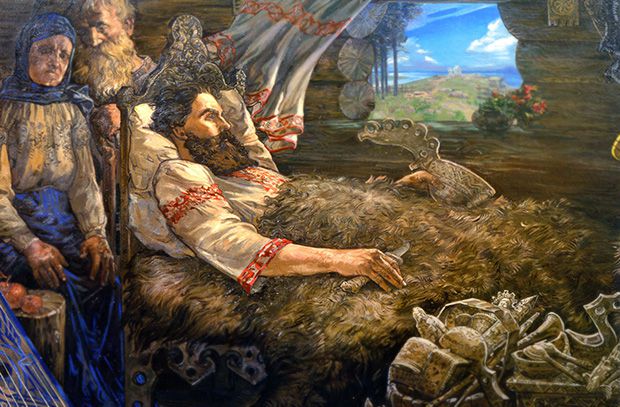
Did you like the article? Share with your friends
Development of creative imagination in preschool children
The use of TRIZ in a preschool institution radically changes the teacher’s teaching style, liberates children, teaches them to think, analyze, look for options and make independent decisions.
TRIZ in preschool pedagogy offers many options for game tasks of various directions. Using the TRIZ method for preschoolers, you can actively influence the development of speech. Develop musical and artistic abilities. Instill a love of nature and instill a sense of empathy in children.
Today we will talk about the development of mathematical abilities, which every child has, but is not activated in every brain. Let's consider several game TRIZ tasks for preschoolers, including logical thinking.
Master class “Morphological analysis - a method for developing creative imagination”
Master class “Morphological analysis - a method for developing creative imagination”
Target:
dissemination of experience in the use of elements of TRIZ-RTV technologies in children of senior preschool age in visual arts classes for the development of their creative imagination
Tasks:
— to form teachers’ ideas about the use of the “Morphological Analysis” method in working with children to develop creative imagination.
— show by personal example the production and use of tables for morphological analysis.
Equipment:
pictures depicting animals, body parts, blank tables for morphological analysis, multimedia presentation, booklets, pencils, glue (for each participant).
Progress of the event
To be successful in the modern world, children need an active life position and the ability to solve problems. This means that the student must be able to work with information, understand current events and situations, be flexible to change, be able to quickly find the right solution and have strong and creative thinking.
Such problems are solved by RTV and TRIZ technologies and their non-standard methods. One of the effective methods for developing children's imagination is morphological analysis.
The essence of the method is that mental operations are based on combination and are carried out using a table where some indicators are set vertically and horizontally.

The intersection of the values of these indicators is the basis of analytical activity. In RTV and TRIZ methods, a separate morphological table is compiled for each creative task.
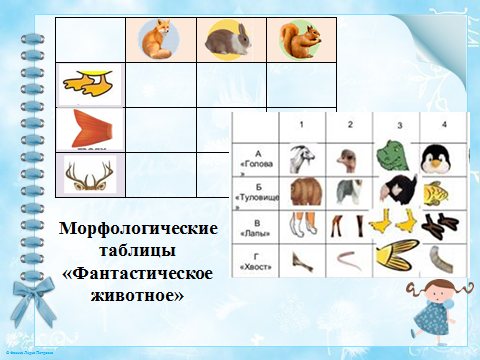
Using the table, children come up with new buildings, clothes, fantastic animals and birds, fairy-tale characters - anything!
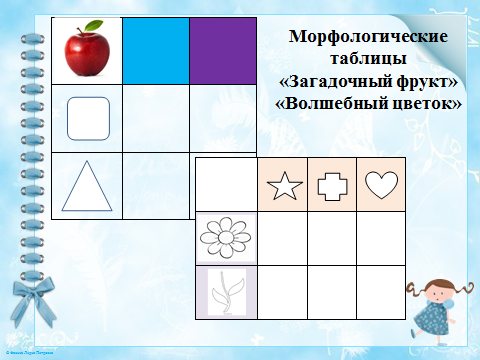
But it is necessary to remember that any fantasy must be embodied in the form of drawings and applications, otherwise the child does not feel satisfied with the creative process and loses interest in it. It is very important for a child to see the result of his creativity, to realize that he created something himself, that he is the talented author of his work.
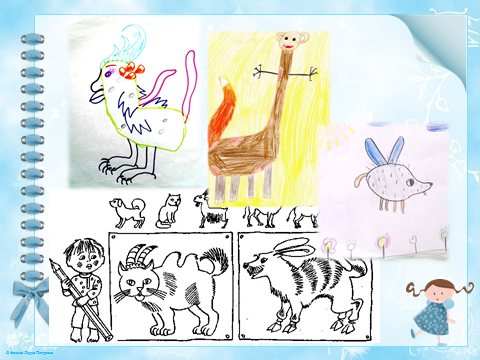
I consider the morphological table to be the most effective in my work, which I use in creative sketches with children. This table is convenient because the number of axes and parameters in it can be modified at will and depending on the object being created.
To make a table on the theme “Fantastic Animal” you will need:
- a table where, depending on the age of the students, 2-4 horizontal and vertical lines can be used;
- pictures of animals, their body parts;
- glue, scissors;
- pencils, watercolors for drawing.

On the horizontal axis we lay out pictures of animals in order: bear, hare, cat, fox. Then we place the animal body parts that we will combine on the vertical axis.
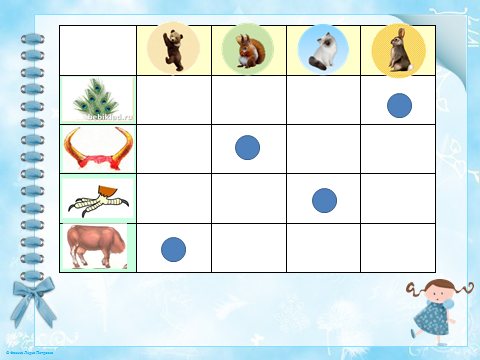
I suggest you draw the resulting animal.
Let me give you another example. Creative assignment on the theme “Fantasy House”. We set the parameters of the drawing vertically: shape, color, material.
Then we place options for parts of the house horizontally: windows, doors, chimney.
We randomly select one characteristic from each row and combine it.

The result is unusual, fantastic houses, with a sheet of paper instead of a door, a window and a chimney in the shape of an orange star.
Using the same principle, my students and I made drawings of an unusual plant and received funny cars and wonderful toys.
Compiled by Deputy Head M.A. Chubakova.
6
